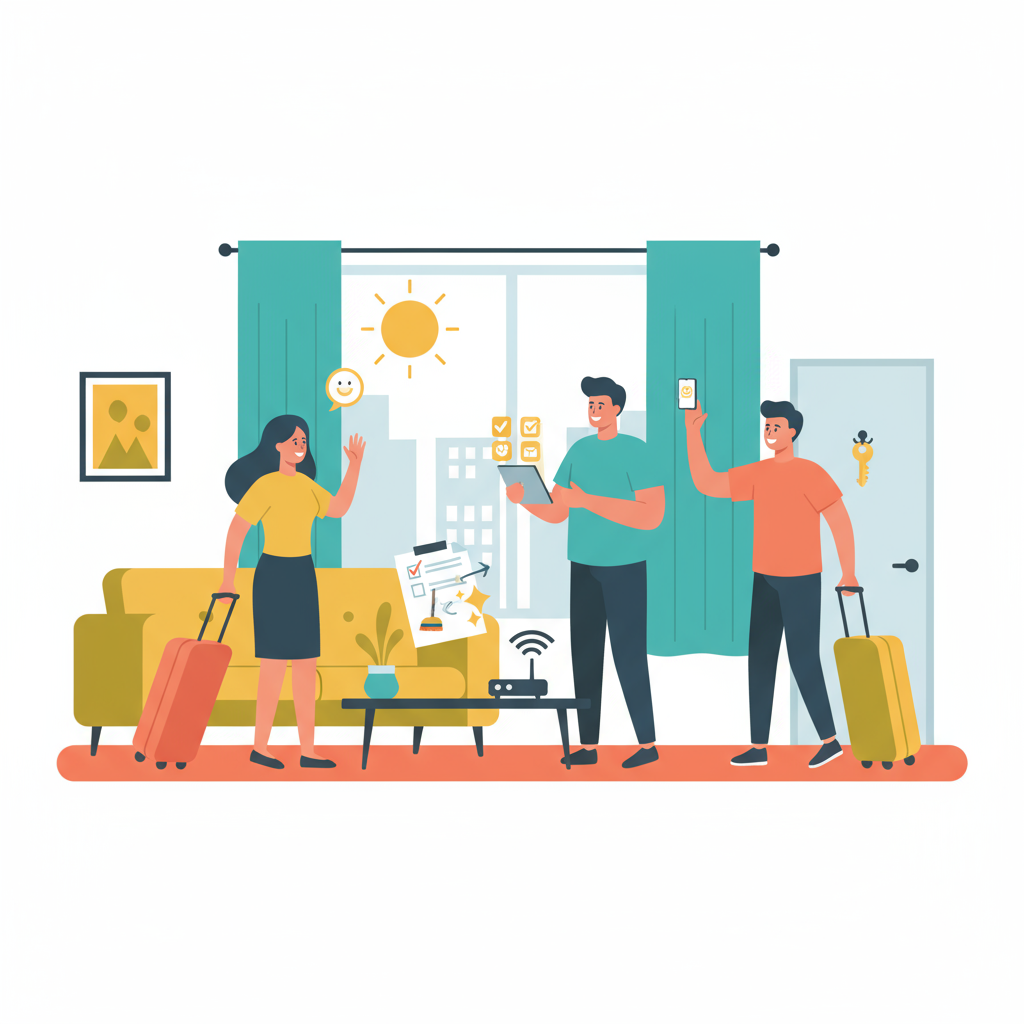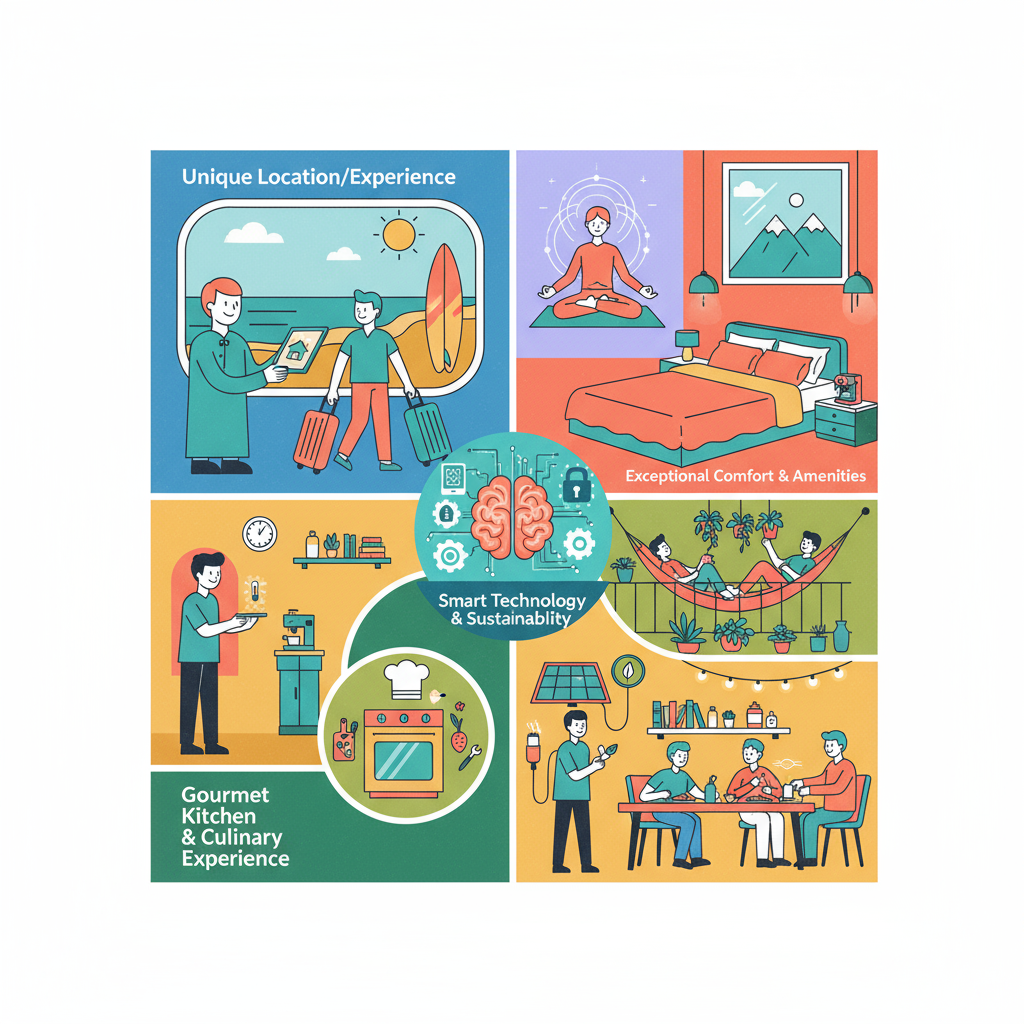Key Takeaways
Airbnb in 2025 promotes seamless digital check-ins, multiple payment options, and experience add-ons.
As Airbnb evolves, you need automation tools that handle messaging, calendar syncing, and team coordination—freeing you from operational quicksand to deliver the hospitality that actually matters.
Position your rentals strategically in neighborhoods with character, not just tourist zones, as Airbnb's algorithm increasingly rewards local authenticity and quick response times.
As a busy short-term rental (STR) host, when was the last time you came up for air? Managing a few short-term rentals elevates Airbnb hosting from side hustle to an all-consuming whirlwind. Between those 11PM guest messages, juggling turnover schedules, and manually tracking income across spreadsheets, you're probably too busy putting out fires to notice how your main booking platform is evolving right under your nose. That constant operational treadmill is exactly why understanding what Airbnb is becoming—not just what it is today—could be your competitive lifeline.
This guide cuts through the chaos to reveal what Airbnb does now, how it's fundamentally reshaping the STR landscape in 2025, and what opportunities you're likely missing while buried in day-to-day operations. We've stripped away the fluff to focus on what matters for busy hosts who need practical insights, not theory.
Definition and Origins
The idea for Airbnb started in 2008 when two designers in San Francisco—Brian Chesky and Joe Gebbia—needed extra cash to cover rent. They inflated a few air mattresses in their apartment and rented them out to travelers. Nathan Blecharczyk, a technical mind with a knack for solving problems fast, soon joined to help turn the setup into a functioning website. The concept was clear: offer short-term stays in lived-in spaces and create a direct connection between guests and hosts.
Back then, the experience felt more like couch-surfing with benefits. Guests stayed in spare rooms, shared kitchens, and often talked with their hosts over coffee. The atmosphere leaned casual, personal, and sometimes quirky. Demand quickly grew beyond shared spaces, however. Entire homes became more popular, and the model shifted from in-home hospitality to private vacation rentals.
Growth timeline
Once the first wave of users arrived, momentum came quickly. Airbnb raised its first seed round in 2009. By 2011, the company had listings in over 89 countries. Funding rounds stacked up, with major investors fueling fast international expansion and pushing Airbnb into unicorn status. The platform's footprint grew from city apartments to countryside villas, and vacation rental managers started paying attention.
As listings expanded, guest expectations changed. Travelers began looking for more than just a roof—they wanted space, comfort, and a local feel. The shift away from hotel-style stays created new standards across the short-term rental market. Hosts suddenly needed to think about photography, amenities, and guest experience in a way that felt more like hospitality and less like a spare-bedroom side hustle.
Key milestones
Several product launches pushed Airbnb into new territory. In 2016, Experiences opened the door for hosts to offer guided tours, cooking classes, and other activities that gave guests a deeper look at local life. Later, extended stays met the growing demand from remote workers and digital nomads who wanted to settle in for weeks or months at a time.
Security also became a bigger focus. Airbnb added identity checks, guest reviews, and a host guarantee to help build trust. Programs like AirCover and the Resolution Center gave hosts and guests a safety net when plans went sideways. On the backend, fraud detection and secure payouts kept transactions smooth and reliable.
So, what is air bnb today? It’s a global booking engine, a payment system, a customer service channel, and a travel marketplace rolled into one. And it all started with an air mattress on a hardwood floor.
So automatic, you won’t know what to do with yourself
Put my rentals on autopilot
It’s simple to automate repetitive tasks with Uplisting's short-term rental software. You’ll save hours every week and eliminate human error. Go ahead — take some time off.
How Airbnb Works
Running short-term rentals through Airbnb means juggling two sides: hosting and guesting. Each side uses different tools but connects through one system that handles listings, search, messages, bookings, and payments. For anyone wondering what is air bnb beyond the homepage, here’s how it actually works behind the scenes.
The host perspective
Everything starts with creating a listing. Hosts upload photos, write a description, select amenities, and set nightly rates. Many hosts use dynamic pricing tools to adjust rates based on demand or season, but they still control minimums, discounts, and how far out guests can book.
Availability runs through a centralized calendar. Hosts can block dates, set minimum stay rules, and sync with other calendars to avoid double bookings. Guest messages arrive in one place, making it easier to manage conversations without jumping between inboxes. Airbnb bumps listings higher in search when hosts respond quickly, so fast replies is directly related to visibility.
Quick communication also smooths out check-ins, solves last-minute questions, and reduces back-and-forth. Message templates or automated replies help hosts stay on top of things without writing everything from scratch. Quick answers lead to better stays, and better stays lead to stronger reviews.
The guest experience
From the guest side, Airbnb runs like a travel search engine. Guests enter a destination, dates, group size, and filters—pet-friendly, pool access, or entire place. Results show pricing, photos, and reviews so travelers can compare based on what they care about.
Each listing shows amenities, house rules, fees, and cancellation policies. Guests can check host profiles, read past reviews, and send pre-booking questions. More transparency means fewer surprises and smoother check-ins.
Booking is straightforward. Guests see the full cost up front, including cleaning fees and tax. Payments go through cards, digital wallets, or local methods like Alipay. Cancellation terms are clearly displayed, so guests know what they’re agreeing to before confirming a stay.
Payment processes and safety features
Airbnb handles every payment in-house to reduce risk. Guests can split the cost with Pay Part Now or use monthly installments for longer stays, depending on the region. This makes higher-priced listings more accessible and spreads out the cost.
Built-in fraud detection adds a layer of protection. Identity checks, encrypted transactions, and behavior tracking flag shady activity early. When something goes wrong, the Resolution Center steps in to review the issue and decide on refunds or compensation.
AirCover protection comes automatically. Guests are covered for last-minute cancellations or listings that don’t match the photos. Hosts get protection for property damage, liability issues, or income loss when cancellations are out of their hands. It’s not a replacement for insurance, but it fills in the gaps when plans fall apart.
The system keeps hosting and booking in one place, so both sides can focus on the stay—not the admin.
Airbnb in 2025
Airbnb in 2025 feels less like a booking site and more like a travel control center. Guests book homes, plan local experiences, and pay all in one place. Hosts keep operations tight using tools that give them speed, clarity, and fewer surprises. For hosts managing a handful of listings, every second saved matters.
Evolving technology and features
Hosts now get real-time booking insights directly in their dashboards. You can see lead time shifts, booking windows by region, and where guests are coming from—live. That means no more scrambling to adjust pricing or minimum stays based on gut instinct.
Digital check-in is now standard. Guests receive unique access codes tied to their reservation times. Entry confirmation shows up automatically, so there’s no need for late-night texts or lockbox confusion.
The Summer 2025 update rolled out a tighter connection between stays and experiences. Guests can reserve both in a single step. Hosts who offer tours, classes, or local walkthroughs can tie those experiences directly to their listings. That’s extra revenue without adding more platforms to juggle.
Payment flexibility
Payment options have widened. Klarna, Alipay, and other regional methods now make booking easier for travelers in Europe and Asia. Long-stay guests can split payments across months, which helps fill calendar gaps without scaring off price-sensitive travelers.
Payouts are faster and more predictable. Hosts choose between same-day transfers, weekly batches, or monthly summaries based on cash flow needs. The platform’s updated fee breakdown shows exact charges. There are no buried line items or surprise deductions.
Impact on the global travel landscape
Travelers now build entire trips on one platform—lodging, experiences, even payments. That shift pushes hosts to think beyond clean sheets and fast Wi-Fi. Guests expect more: local tips, thoughtful design, and easy check-ins backed by strong communication.
Community-first travel is also making a comeback. Guests are skipping tourist-heavy areas and booking neighborhoods with character, owned by hosts who know their cities. Listings packed with local design and neighborhood guides now climb higher in search results.
So, what is air bnb in 2025? It’s where trips begin—and where short-term rental operators can run lean, smart businesses without chasing bookings across different tools.

All-in-one Vacation Rental Software and Channel Management System
Get started in seconds by connecting Airbnb
Manage short-term rentals & bookings, message guests, take payment, and so much more. All in one easy-to-use platform (that never double-books).
Advantages and Limitations
Benefits for small-scale hosts
Running a few short-term rentals through Airbnb often means earning steady income without hiring staff or managing a full operation. You don’t necessarily need to build a website, create a marketing plan, or hire a revenue manager. Airbnb handles exposure, booking flow, and payment processing in one place, which cuts down admin time and reduces the chance of missed messages or double bookings.
The platform brings instant visibility to listings, putting properties in front of millions of travelers around the world. Hosts don’t have to spend on paid advertising or worry about search engine rankings. If the listing is priced right and reviewed well, it moves up in search. That kind of reach is especially helpful when managing a small portfolio with limited time or resources.
Potential drawbacks
There’s a tradeoff when relying on a platform you don’t control.
Service fees eat into earnings with every booking—especially on short stays or lower rates where margins are already tight. Some hosts also absorb cleaning fees or guest discounts to stay competitive, which leaves even less room to cover operational costs like laundry, maintenance, or turnover labor.
Regulations add another layer of pressure. Rules change constantly, and they’re rarely consistent across cities or even neighborhoods. One street may allow short-term rentals, while the next requires costly permits or bans them completely. Hosts often spend hours navigating local policies or adjusting calendars to stay compliant.
Regulations and criticisms
Local governments continue tightening restrictions on short-term rentals. Many require registration, enforce stay limits, or cap how many properties a single host can operate. In some areas, hosts must pay occupancy taxes, install smoke detectors that meet commercial code, or update insurance to meet city standards. These rules can shift overnight, and staying current often means checking city council agendas or industry forums weekly.
Not everyone welcomes more vacation rentals on their block. Residents in high-demand cities report noise complaints, guest traffic, and shrinking rental availability for long-term tenants. Some argue that more STRs drive up rent by removing housing stock from the market. Others raise concerns about safety or quality-of-life changes in residential neighborhoods.
So, what is air bnb in 2025? For some, it’s a flexible source of income. For others, it’s a flashpoint in the conversation about housing, tourism, and who gets to shape a neighborhood.
Where Short-Term Rentals Fit
Short-term rentals didn’t just appear out of nowhere. They carved out space between hotels and long-term leases. Travelers want more space, better value, and something that feels local. Operators want flexibility, control, and a way to grow without hiring a full team. Airbnb didn’t invent that need, but it built the system to meet it at scale.
Airbnb vs. traditional hotels
Hotels still win on predictability. Room service, front desks, daily housekeeping—it’s all built-in. However, they can’t compete with how personal rentals feel. A guest might sleep in a 1920s Craftsman one week and a tiny home with a rooftop deck the next. That variety is the draw.
Rates also matter. A family booking three hotel rooms for a week pays far more than they would for a three-bedroom rental with a kitchen and backyard. And with that price difference, guest expectations shift. A clean room is the bare minimum. Seamless self check-in, fast Wi-Fi, and a space that feels like home all get rolled into the stay.
Still, short-term rentals don’t come without friction. No front desk means no one to call when the Wi-Fi drops or the thermostat resets. A high-maintenance guest won’t care that the host lives in another state. And while some travelers love the idea of quirky spaces, others see them as a gamble. Cleanliness, clarity, and speed matter more when the service layer is remote.
Online travel platforms
Airbnb usually gets most of the attention, but it’s not the only booking channel hosts use. Vrbo, Expedia, and Booking.com all list vacation rentals alongside hotels. Each one attracts different guests, uses different fee structures, and handles support differently. Hosts juggling more than one platform need to plan for that.
Vrbo tends to draw families looking for entire homes. Booking.com leans hotel-heavy, so its guests often expect front-desk-level support. Expedia sits somewhere in the middle, pulling in both hotel and rental traffic. A listing that performs well on Airbnb might underdeliver elsewhere unless it’s tailored to that platform’s audience.
Adding more channels gives hosts more reach, but also more admin. Calendars need syncing. Messaging needs streamlining. If the tools running in the background can’t keep up, mistakes happen fast. Double bookings, missed reviews, and pricing mismatches can all chip away at trust, even when the space is spotless. That's where a property management system (PMS) like Uplisting can be a lifesaver.
Local and global community effects
Short-term rentals bring more visitors to neighborhoods that used to go unnoticed. A single well-run listing can quietly boost nearby restaurants, coffee shops, and tour operators. In small towns and slow seasons, that extra foot traffic makes a real difference.
Not everyone sees rentals as a win. Cities with limited housing stock often blame vacation rentals for driving up prices. Some neighbors complain about noise, trash, or strangers coming and going every few days. In areas with no clear rules, hosts can get caught between staying profitable and staying legal.
Running a rental long-term means operating with the neighborhood in mind. That includes setting quiet hours, posting clear house rules, and choosing the right location to begin with. Guests can’t respect a place they don’t understand, and hosts can’t afford to ignore the community around them.
What is air bnb in 2025? It’s where short-term rentals live, grow, and get challenged, all at once.
Create 5-star guest experiences
Give your guests unforgettable experiences
With Uplisting, you can send the right messages at the right time on all booking sites. Read and respond to guest messages in a single, unified inbox — whether you’re at the office or on the go.
How to Succeed on Airbnb in 2025
Guests expect reliability. Booking platforms demand accuracy. And operators balancing a few properties need a setup that doesn’t depend on late-night calendar checks or guesswork.
Here’s where to focus next.
Automate slow tasks that drain your time
Manual updates eat hours. Confirmation messages, check-in instructions, and review reminders don't need a personal rewrite every time. Uplisting's automated messaging system lets you set up custom flows that trigger based on booking stages—from reservation confirmation to post-checkout feedback requests. Trigger cleaner notifications the moment a guest checks out through Uplisting's team management tools. The platform's real-time calendar sync works across all major booking channels to prevent double bookings without babysitting every date.
Automation doesn't replace the host experience, it just clears space for it. With Uplisting handling these repeatable tasks, you can spend more time improving guest stays and solving real problems that actually require your personal touch.
Keep pricing flexible and intentional
Rates that never change miss real opportunities. Prices should shift with demand, booking windows, and local events. Dynamic pricing tools help with adjustments, but they work better when you guide them.
Set a minimum rate that covers costs. Use longer minimum stays during peak seasons to reduce turnover headaches. Watch how far in advance bookings come in. If guests book months out, your base price might be too low. If no one books until the last minute, it could be too high. Price changes shape who books and when, not just your revenue.
Build in quality checks—not just hope
Consistency matters more than almost anything else. Guests remember properties that deliver exactly what the listing shows. Skipping photo-proofed checklists during turnovers or relying on “should be fine” setups leads to missed details.
Use turnover checklists every time. Standardize bedding, towels, and amenities across properties to reduce supply mix-ups. Scan reviews for repeat complaints—like missing instructions or confusing locks—and fix them quickly.
Quality control about building a system that avoids problems in the first place.
Plan for what’s changing next
Airbnb has evolved from a simple peer-to-peer rental platform into a global travel ecosystem, reshaping how guests book stays and how property managers run their businesses. As we look ahead to 2025, Airbnb continues to set the pace for short-term rentals—offering more tools, tighter integrations, and higher guest expectations than ever before.
Regulations shift. Guest preferences evolve. Platforms roll out updates without warning. Staying ready means having tools and systems that adjust with you. For anyone still asking what is air bnb in 2025: it’s a booking platform that changes fast, and hosts need to keep up without reworking everything from scratch.
Set up your workflow to handle more without adding stress. Use a platform like Uplisting that connects calendars, guest messages, pricing, and team tasks in one place. That way, expanding from one property to three doesn’t mean doubling your workload.
For hosts, the opportunity is clear, but so is the complexity. Success in this space demands reliable systems, automation, and the flexibility to adapt quickly.
FAQs about Airbnb
How does Airbnb differ from a hotel?
Hotels stick to predictable layouts and services. Airbnb offers more variety and character. Guests choose between city lofts, mountain cabins, backyard studios, and even converted buses. Each space reflects the host’s style, so no two stays feel the same. Communication stays personal. Guests message the host directly for check-in instructions, local recommendations, or help during the stay. That kind of flexibility and connection doesn’t come with a front desk.
What are typical fees?
Guests typically see a 14-17% service fee added to the nightly rate, which helps cover support and payment processing. Hosts pay either a flat 3% fee or, if using Simplified Pricing, approximately 14.2% of the booking subtotal. Some listings include cleaning fees(averaging $65-150 depending on property size), pet fees ($20-100 per stay), or occupancy taxes(varying by location from 5-15%). All these charges show up clearly itemized before payment, so guests know exactly what they're paying from the start.
Why is it called Airbnb if there is no breakfast?
Back in 2008, the original idea was to rent out air mattresses on the floor and offer breakfast in the morning. The name came from that setup—“AirBed & Breakfast.” Over time, the breakfast part disappeared, but the name stuck around. Now when someone asks, “What is air bnb?,” the answer has little to do with food and everything to do with staying like a local in a space that feels more personal than a hotel room.

















.png)

